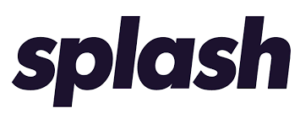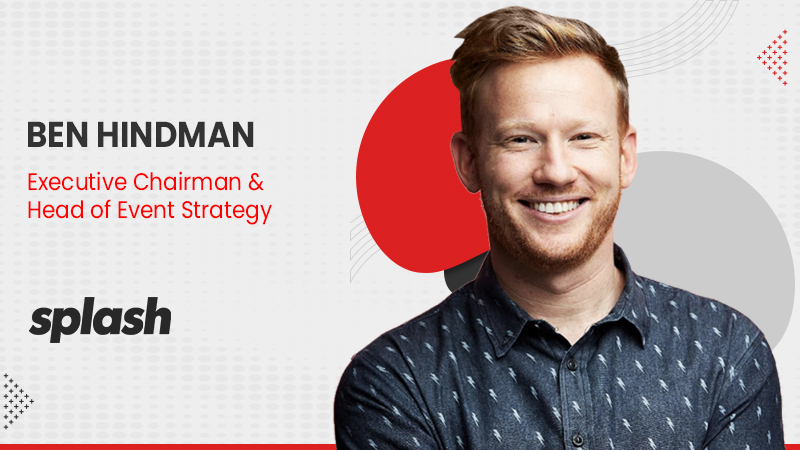We have a better view of how to make virtual, in-person, and hybrid events a more integrated experience — so that even if an event feels big it can also feel small, which is a powerful way to think about events.
Hi Ben, tell us a little about your journey in Tech?

I am an event marketer turned technologist, which is to say I understand the power of human connection after years of planning and executing events at the ground level. It’s that experience that I bring to the technology side within event platforms.
When launching Splash, I found that my ability to empathize with the customer experience, my appreciation of the brand story, and my hunger to build moments of surprise and delight, became transferable and dependable skills when going from actual events into event technology. In technology, I became proficient at Keynote as a way of making event recaps, and I used that skill to design Splash with my CTO (from Keynote to code, we used to say).
After tinkering with a few different iterations of the platform, Splash caught fire at SXSW 2012 and the rest is history.
How has the Covid-19 Pandemic reshaped your view of the business environment that your business operates in?
Obviously, the pandemic impacted every aspect of the event industry in a dramatic way. But in some respects, it confirmed my view on what events could be. When forced to leverage technology to create integrated experiences and connections, events became both more efficient and measurable than what we’ve been conditioned to expect. I believed that was the direction the industry was heading when I started Splash, and the realities of the pandemic accelerated that evolution.
I think we also discovered that small and intimate can be just as profound, or even more so, than the big spectacle. With grand events put on hold during the pandemic, I was made to appreciate that smaller events — and the importance of building an online community — are wonderfully impactful. An intimate event is a targeted event, so coming out of the pandemic, I’d say we have a smarter and more integrated product set that better facilitates smaller gatherings. We have a more focused use case for field marketing. We have a better view of how to make virtual, in-person, and hybrid events a more integrated experience — so that even if an event feels big it can also feel small, which is a powerful way to think about events.
What sets Splash apart from the competition?
It’s a couple of things. First, it’s our platform’s ability to be a one-stop shop. Whether a company is looking to present an in-person, virtual or hybrid event, Splash’s technology helps before (outreach and registration), during (execution and engagement), and after (follow-up connections and reporting). Splash manages this all through a single platform with in-house streaming and engagement features like chat and online polls, along with a wholly synced data flow for both online and in-person events. Essentially, there’s no need to outsource or juggle multiple tools, which is a big pain point for some event teams.
Second, we put a greater focus on integrating with existing systems than our competitors do, which is a game-changer in terms of tracking and measuring event ROI. Too often, event technology lives in a silo. How can you assess the impact of an event if you can’t attribute business outcomes to event activity? By ensuring that the Splash platform can connect to a company’s existing CRM tool (or similar system), we make it possible to track all event-related interactions back to the business development pipeline, which is a crucial advantage.
Finally, Splash has always championed the democratization of event planning and marketing within an organization, and our solutions deliver on that ambition. Our platform is designed to let multiple teams engage in the event process, replicate branded and designed events without needing specialized training, and collaborate effectively with multiple event stakeholders. When those teams that benefit from an event are more involved in the planning and marketing process, the more effective that event can be.
What direction do you envisage Event Engagement taking, in the years to come?
Hybrid is the way. To some degree, the pandemic may have introduced a virtual event experience as a stopgap for canceled in-person events, but I see a virtual component being a part of nearly every event in the future. As technology grows and event marketers test and learn new ways to engage attendees online or via a mobile experience, virtual aspects are only going to get stronger with time. Event marketers will also grow and improve how they interweave the virtual with the in-person experience to develop one dynamic show.
It’s an exciting future, thinking of how much a virtual event tech can elevate the overall event experience, and it won’t feel like a stopgap but a high-quality, immersive interaction. Remember, just as people got used to working remotely and splitting time in-office or at-home, event attendees will want that same flexibility in conferences and events. Customers want flexibility, and if event marketers deliver an engaging virtual component, then they’ll get that flexibility.
What 3 things can business owners do to optimize their event marketing?
First, invest in the right technology. Don’t try to build a virtual event experience using old technology or what you’ve relied on previously for webinars or day-to-day remote meetings. Event attendees will notice and remember.
Secondly, make engaging attendees the chief priority for your events, and measure that engagement as best you can. This is key for both in-person and virtual events. What are you doing to get attendees involved? How are they interacting, not just with your event content but with one another? Seeing a big crowd at a live, in-person show, or seeing high registration numbers online isn’t enough to measure the success of an event. It’s the connections that attendees walk away with that matter.
And lastly, to build on that point, event professionals need to measure better. Especially with a hybrid event that may have disparate data sources — tracking in-person activity and online activity is the key to improving how you measure the success of an event. To do that effectively, you need to have one dashboard tracking integrated behavior and ROI, and an event platform that connects with your other systems for measuring pipeline progress.
As a Business Leader, what is the one piece of advice you would give to those who aspire to the C-suite?
Great leaders host magical meetings.
Your top pick for a book on marketing that everyone should read?
For one, all marketers should have the “The Copywriter’s Handbook” by Robert Bly squarely positioned on their desks at all times. I also recommend “The 15 Commitments of Conscious Leadership: A New Paradigm for Sustainable Success,” by Jim Dethmer. It highlights a healthier way to lead.
Could you name one other marketer (or more) that you would like to see featured here?
I’ll give you three:
- Kate Hammitt, CMO, Splash
- Lindsay Niemiec, VP, Enterprise and Event Marketing, Pendo.io
- Ally Masi, Director of Industries Events Marketing, Salesforce
Kate I obviously know very well and her approach to marketing strategy and team-building is something your audience would be interested in learning. But all three of these women are in the vanguard of event marketing leadership and are innovative thinkers in their own right.
What are the key ingredients that make a successful marketer?
I think the first ingredient is good storytelling, because you can’t engage the audience without a good story to tell. I also believe marketers should lean into non-linear thinking to inspire them to break the mold and not recycle the status quo. Lastly, go through the experience of failing, that is a key ingredient. A lot can be learned from that experience, not just on a business level, but a human one.
The top 3 events that you have attended in the last decade and what made them so memorable?
I would say first is the Haute Domikazo Secret Family Reunion. It was an experience of just giving yourself over to the event, and it was incredible. You’re armed with only your passport, and you give way to the surprise and delight. I also would mention the Summit Series, an incubator of inspiration, and Shopify Core Bursts. But what made all three events so memorable is that they invited the attendees to co-create the experience. That level of attendee engagement was a conscious choice on their part, and it made all three of these events that much more memorable.
Thanks Ben!
About Ben:
Ben Hindman is the Executive Chairman and Head of Event Strategy at Splash, a next-generation event marketing platform that provides event marketers and field marketing teams the tools they need to design, create, and execute virtual, in-person, and hybrid event programs. Hindman co-founded the events company nearly 10 years ago, working alongside technologists, designers, marketers, and party planners to make sense of the events industry by anticipating trends, identifying user needs, and finding the next great laser light.
Read More: IT Digest Interview with Matt Keating, Sales Director at VDX.tv
































